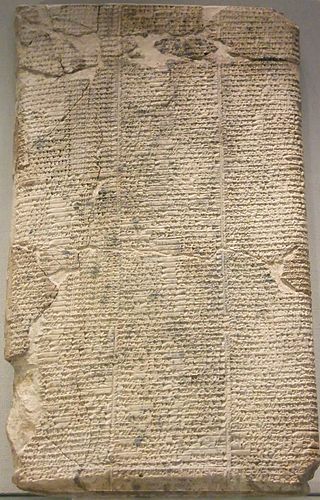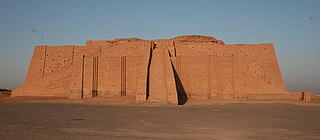
The Sumerian King List or Chronicle of the One Monarchy is an ancient literary composition written in Sumerian that was likely created and redacted to legitimize the claims to power of various city-states and kingdoms in southern Mesopotamia during the late third and early second millennium BC. It does so by repetitively listing Sumerian cities, the kings that ruled there, and the lengths of their reigns. Especially in the early part of the list, these reigns often span thousands of years. In the oldest known version, dated to the Ur III period but probably based on Akkadian source material, the SKL reflected a more linear transition of power from Kish, the first city to receive kingship, to Akkad. In later versions from the Old Babylonian period, the list consisted of a large number of cities between which kingship was transferred, reflecting a more cyclical view of how kingship came to a city, only to be inevitably replaced by the next. In its best-known and best-preserved version, as recorded on the Weld-Blundell Prism, the SKL begins with a number of antediluvian kings, who ruled before a flood swept over the land, after which kingship went to Kish. It ends with a dynasty from Isin, which is well-known from other contemporary sources.

Magan was an ancient region in what is now modern day Oman and United Arab Emirates. It was referred to in Sumerian cuneiform texts of around 2300 BCE and existed until 550 BCE as a source of copper and diorite for Mesopotamia. As discussed by The Archeology Fund founded by Juris Zarins, "The Sumerian cities of southern Mesopotamia were closely linked to the Gulf. Archaeologists and historians have linked sites in Saudi Arabia, Bahrain, and Qatar to the Sumerian geographical term of Dilmun. Oman, was most likely the Sumerian Magan".

The Lament for Ur, or Lamentation over the city of Ur is a Sumerian lament composed around the time of the fall of Ur to the Elamites and the end of the city's third dynasty.

Aratta is a land that appears in Sumerian myths surrounding Enmerkar and Lugalbanda, two early and possibly mythical kings of Uruk also mentioned on the Sumerian king list.

Ibbi-Sin, son of Shu-Sin, was king of Sumer and Akkad and last king of the Ur III dynasty, and reigned c. 2028–2004 BCE or possibly c. 1964–1940 BCE. During his reign, the Sumerian empire was attacked repeatedly by Amorites. As faith in Ibbi-Sin's leadership failed, Elam declared its independence and began to raid as well.

The Awan Dynasty was the first dynasty of Elam of which very little of anything is known today, appearing at the dawn of historical record. The Dynasty corresponds to the early part of the Old Elamite period, it was succeeded by the Shimashki Dynasty and later the Sukkalmah Dynasty. The Elamites were likely major rivals of neighboring Sumer from remotest antiquity; they were said to have been defeated by Enmebaragesi of Kish, who is the earliest archaeologically attested Sumerian king, as well as by a later monarch, Eannatum I of Lagash.
The Dynasty of Isin refers to the final ruling dynasty listed on the Sumerian King List (SKL). The list of the Kings of Isin with the length of their reigns, also appears on a cuneiform document listing the kings of Ur and Isin, the List of Reigns of Kings of Ur and Isin.

The Guti, also known by the derived exonyms Gutians or Guteans, were a people of the ancient Near East who both appeared and disappeared during the Bronze Age Their homeland was known as Gutium.
Kazalla or Kazallu (Ka-zal-luki) is the name given in Akkadian sources to a city in the ancient Near East whose locations is unknown. Its god is Numushda with his consort Namrat. There are indications that the god Lugal-awak also lived in Kazallu.

Sumerian literature constitutes the earliest known corpus of recorded literature, including the religious writings and other traditional stories maintained by the Sumerian civilization and largely preserved by the later Akkadian and Babylonian empires. These records were written in the Sumerian language in the 3rd and 2nd millennia BC during the Middle Bronze Age.

Ishbi-Erra was the founder of the dynasty of Isin, reigning from c. 2017 — c. 1986 BC on the middle chronology or 1953 BC — c. 1920 BC on the short chronology. Ishbi-Erra was preceded by Ibbi-Sin of the third dynasty of Ur in ancient Lower Mesopotamia, and then succeeded by Šu-ilišu. According to the Weld-Blundell Prism, Išbi-erra reigned for 33 years and this is corroborated by the number of his extant year-names. While in many ways this dynasty emulated that of the preceding one, its language was Akkadian as the Sumerian language had become moribund in the latter stages of the third dynasty of Ur.
Shu-Ilishu was the 2nd ruler of the dynasty of Isin. He reigned for 10 years Shu-Ilishu was preceded by Išbi-erra. Iddin-Dagān then succeeded Shu-Ilishu. Shu-Ilishu is best known for his retrieval of the cultic idol of Nanna from the Elamites and its return to Ur.
Iddin-Dagan, fl.c. 1910 BC — c. 1890 BC by the short chronology or c. 1975 BC — c. 1954 BC by the middle chronology) was the 3rd king of the dynasty of Isin. Iddin-Dagan was preceded by his father Shu-Ilishu. Išme-Dagān then succeeded Iddin-Dagan. Iddin-Dagan reigned for 21 years He is best known for his participation in the sacred marriage rite and the sexually-explicit hymn that described it.
The Correspondence of the Kings of Ur (CKU), also known as the Royal Correspondence of Ur, is a collection of 24 literary letters written in the Sumerian language and attributed to kings of the Ur III period, 2048–1940 BCE. They are known primarily from copies dating to the Old Babylonian period, ca. 1800–1600 BCE; their original date of composition and their historical accuracy are debated.

The lament for Sumer and Urim or the lament for Sumer and Ur is a poem and one of five known Mesopotamian "city laments"—dirges for ruined cities in the voice of the city's tutelary goddess.

The Shimashki or Simashki dynasty (Šimaški), was an early dynasty of the ancient region of Elam, to the southeast of Babylonia, in approximately 2100–1900 BCE. A list of twelve kings of Shimashki is found in the Elamite king-list of Susa, which also contains a list of kings of Awan dynasty. It is uncertain how historically accurate the list is, although some of its kings can be corroborated by their appearance in the records of neighboring peoples. The dynasty corresponds to the middle part of the Old Elamite period. It was followed by the Sukkalmah Dynasty. Shimashki was likely near today's Masjed Soleyman.
The Isin-Larsa period is a phase in the history of ancient Mesopotamia, which extends between the end of the Third Dynasty of Ur and the conquest of Mesopotamia by King Hammurabi of Babylon leading to the creation of the First Babylonian dynasty. According to the approximate conventional dating, this period begins in 2025 BCE and ended in 1763 BCE. It constitutes the first part of the Old Babylonian period, the second part being the period of domination of the first dynasty of Babylon, which ends with the Sack of Babylon in 1595 BCE and the rise of the Kassites.

Awan was an ancient city-state or region of Elam in the western area of modern-day Iran. It often appears together with the cities of Susa and Anshan in the early history of Mesopotamia, having many conflictual interactions with Sumer.

The Renaissance of Sumer is a period of the history of Mesopotamia that includes the years between the fall of the Akkadian Empire and the period of the Amorite dynasties of Isin and Larsa—both with governments of Semitic origin—between the centuries 22nd B.C. and 21st B.C. Within this stage the years of the so-called Third Dynasty of Ur or "Ur III" stand out, because of the new hegemony that would embrace all Mesopotamia, this time with the city of Ur at the head.
























